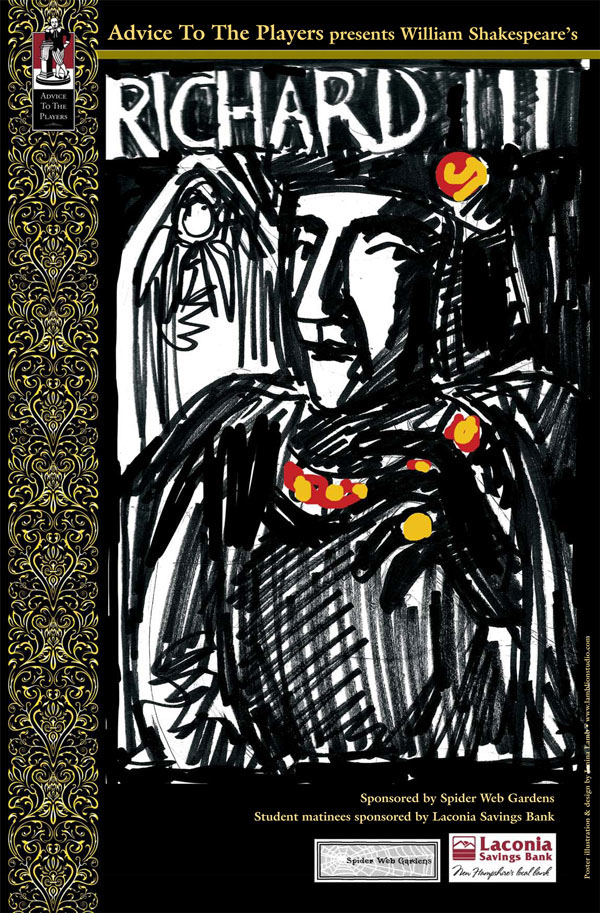
The finished poster minus its informational text
My first step in making a poster for an Advice To The Players production is to read or watch the play. I prefer to watch it if possible; it is a play after all. In preparation for designing a poster for Shakespeare’s Richard III I watched an old BBC production with a young Ron Cook playing Richard. I thought he was marvelous . . . devilishly self-aware, a consummate actor playing a consummate actor, and hot, in a smarmy, creepy way. Richard III was an original bad boy.
I find Richard, as Shakespeare and Ron Cook portrayed him (historical accuracy be damned) to be a greater villain than Iago, who usually gets the Bard's Blue Ribbon for evil. I see Iago as a nutcase obsessed with one man; Shakespeare’s Richard let no one stand in the way of his ambitions and apparently had no inhibitions in getting what he wanted by any means—manipulation, insincerity, or the crudest violence.
There is a wonderful discussion of Richard III’s character in Dorothy L. Sayers' Peter Wimsey novel, Have His Carcase:
"Matter of fact," he (Sullivan, a casting agent) adds, “that’s a difficult part to cast for. Inconsistent, to my mind. You mightn’t think it, but I do a bit of reading and thinking now and again, and what I say is, I don’t believe W. Shakespeare had his mind on the job when he wrote that part. Too slimy at the beginning and too tough at the end. It ain’t nature. Not but what the play always acts well. Plenty of pep in it, that’s why. Keeps moving. But he’s made Richard two men in one, that’s what I complain of. One of ‘em’s a wormy, plotting sort of fellow and the other’s a bold, bustling sort of chap who chops people’s heads off and flies into tempers. It doesn’t seem to fit, somehow, eh?”
“I always think,” said Wimsey, “that Shakespeare meant Richard to be one of those men who are always deliberately acting a part—dramatizing things, so to speak. I don’t believe his furies are any more real than his lovemaking. The scene about the strawberries—that’s clearly all put on.”
What he said. That’s how I see Richard, too. A real con artist—a song-and-dance salesman packing heat for those unmoved by his spiel. My first artistic intuition/impulse was to combine something rough with something smooth, the roughness representing Richard’s own crappy self and the smoothness representing both his wiles and the glamour and elegance of worldly power to which he aspired. The image that came to me was of a rough sketchy drawing of Richard using black lines, maybe brush and ink, combined with intricate and delicate patterns of some kind.
The first draft I made looked like this:

I had already found the gold filligree on the side and I had a general idea of the layout. The image behind Richard's left shoulder represents a stained-glass window I found of Lady Anne which I though might work. The red and gold blobs are jewelry. Mostly I lifted the jewelry from an old painting of Richard:

I did a drawing in charcoal which I scanned, though in the end I didn't take much advantage of the charcoalness. The poster really began to come together when I got the idea of using a background painted by my daughter, Rosy Lamb. It had the energetic roughness I was looking for and inspired everything else.


For a while I thought I was going to paint Richard's face, but in the end I wanted the background to show through. The hair is a transparent color, and the clothing is the background pushed towards red to distinguish it from the real background. What I found in this process is pretty much want I always find in the artistic process (including the artistic life process)—that what works best is not knowing—following an intuitive path and seeing where it leads.
To be more specific about what 'not knowing' means, it means not knowing everything. It means seeing a picture that is like a jigsaw puzzle with a whole bunch of pieces missing. You can kind of see where it's going but you can't see the finished product until you put in more pieces, and unlike a real jigsaw puzzle, where the picture and the pieces already exist even if you haven't put them together yet, in life and art the pieces you can see may very well change their form and content as new pieces emerge.
This is a different model than the 'list' model, than the 'having all your ducks in a row' model, than the 'if it doesn't fit into my schematic it doesn't exist' model. It's the messy, faith-based model, and if you use it, the chances are higher that you will create something more true, complex, and interesting than if you leave out everything you can't see or don't understand at the beginning.
Faith in what, exactly? you may be asking. Faith in a profound integration that can only be realized through the particularity of time, space and personality. And the personality is at the center, so it can't see itself, it can only come into being through the act of making. There is no easier way to become than to not know.


